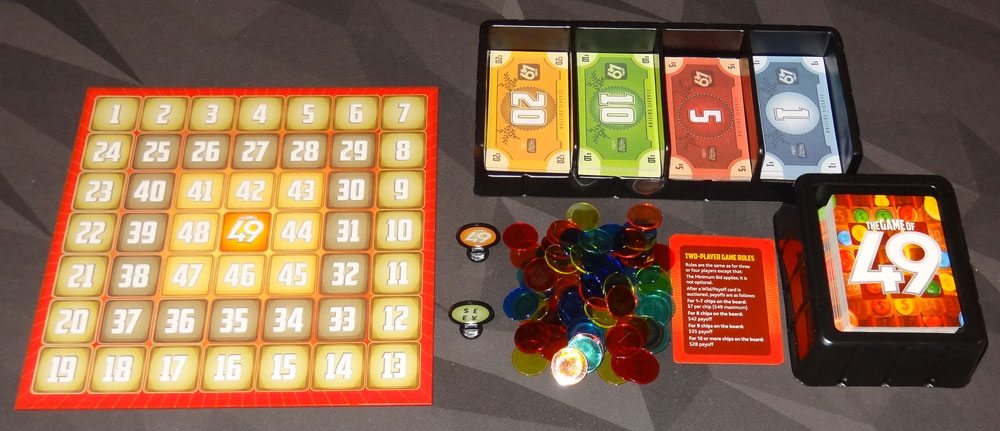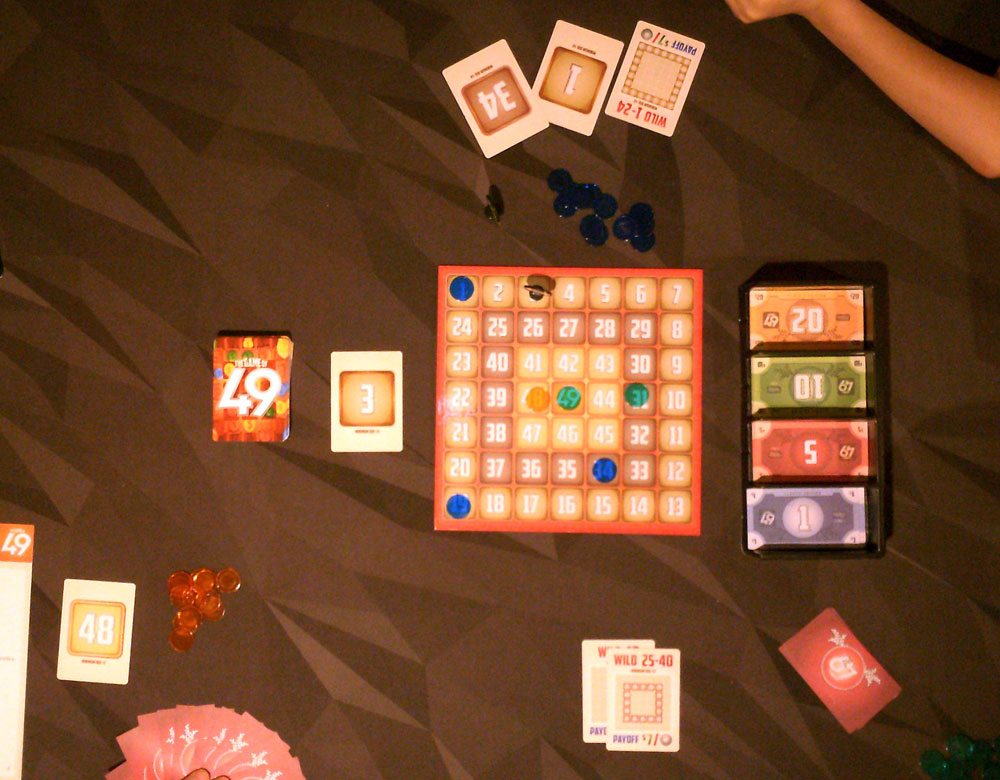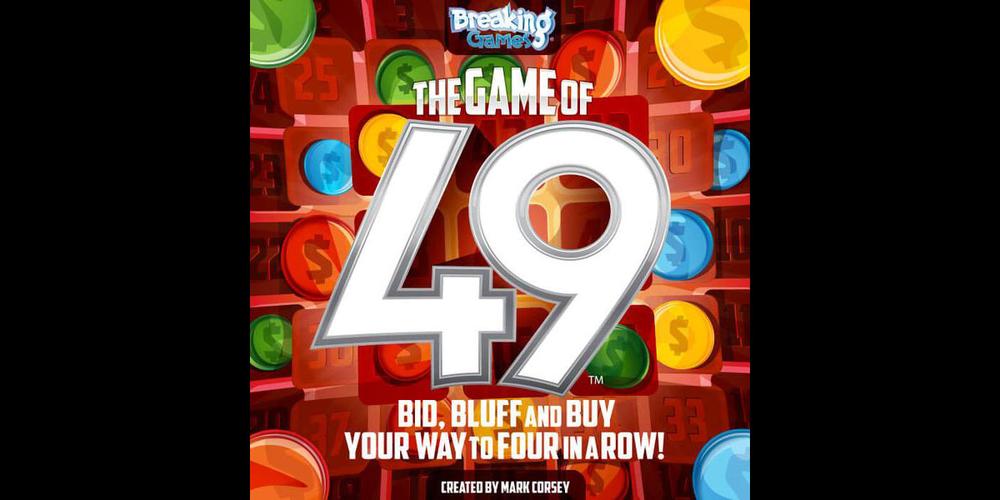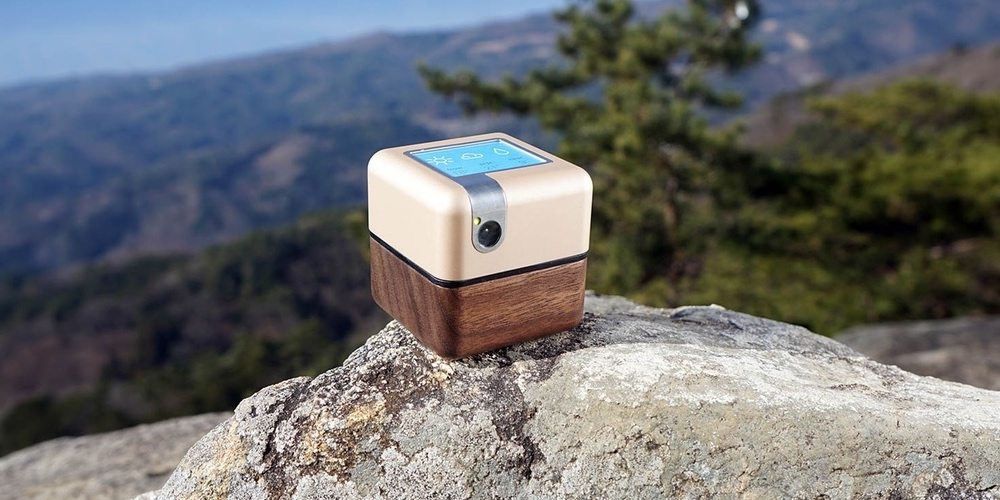The Game of 49 is a four-in-a-row game with a twist: you must bid on locations to place your chips, but you’ll also earn payouts for having chips on the board.
At a glance: The Game of 49 is a family-friendly game by Mark Corsey for 2 to 5 players, ages 10 and up, and takes about 45 minutes to play. It’s a Kickstarter success story: it was originally funded in 2014 and then published by Breaking Games. This summer, the new edition hit shelves at Target. It retails for $19.99. I’ve played with my 9-year-old and I’d say you could probably go a little younger than 10—the auction and 4-in-a-row rules are not too complicated. (It’s the budgeting that’ll get you.)

Components
- Game board
- 75 chips (15 each in 5 colors)
- Active Player token
- Current Auction token
- Money tray
- 60 number cards (48 regular and 12 Wild/Payoff)
- Paper money (in $1, $5, $10, $20 denominations)
The components are pretty straightforward, functional but nothing especially fancy. The Active Player token and Current Auction token have very small bases so they’re very easy to knock over. It’s been a while since I’ve played a game with paper bills, and I did find it a bit troublesome (particularly when the bills are brand new and stick together). However, in this game your total holdings are secret, and the bills all have the same back, so you can do a bit of bluffing about how much money you actually have, which would be harder to do with chips or tokens unless you had player screens. And, according to the Kickstarter campaign, the designer and many people who playtested the game just had a certain nostalgia for paper money, riffling through it and counting it, and I could see my daughters were taken with it, too. There’s a money tray and card tray in the box, though these are very thin plastic.
The board has 49 numbered squares on it, with the numbers increasing in a spiral into the center. Each of the concentric “rings” of squares is shaded differently, matching some of the Wild cards in the deck. The 48 regular cards each show a single number from 1 to 48, along with a minimum bid amount. The 12 Wild/Payoff cards each show an entire ring of the board or the “49” in the center, plus a reminder text at the bottom about a payoff.

How to Play
The goal of the game is to get 4 of your chips in a straight line on the board—orthogonally or diagonally.
To set up, give everyone a set of chips and $49, and shuffle the cards.
The active player flips over the top card of the deck and starts the bidding. (The Current Auction token is used to mark the space shown on the card, if it is a single number.) Players bid or pass in turn order until there’s only one player left—once you’ve passed, you may not re-enter the bidding for that card. The highest bidder pays the bank, takes the card, and then marks the spot on the board with a chip.

The Wild cards are a little different: instead of a single number, they show a range of numbers corresponding to a ring of spaces on the board (or the “49” in the center). If you win the auction for a range of numbers, you get to pick any open spot in that range. If you win the “49” card, you may bump another player if there’s somebody there already. And if you’re already on the “49” and you win that card, you get to put one token on any empty space on the board. After a Wild auction is concluded and the token is placed, everyone who has tokens on the board gets a payout: $7 per token, maximum $49.
One note: because of these Wild cards, sometimes you’ll flip a number card and it’s already occupied—if that happens, you just discard it and draw the next card.
If you ever win an auction and have bid more money than you have (it’s an honor system and technically you’re not supposed to bid more than you have), you must remove a token from the board as a penalty, and then that space goes back up for auction again.
The game ends immediately if any player wins by getting four tokens in a row.
There are a few variant rules, like the “check” rule: when you start an auction, you may “check” instead of passing or bidding—basically you don’t start the bid but reserve the right to jump back into the auction if bidding happens. All players may check until an opening bid is placed, but if all players check, the card is discarded and nobody buys it.
The minimum bid is also an optional rule: each card has a minimum bid printed on it (the closer to the center, the higher the bid) and you must bid at least that much to start the bidding.
The two-player version of the game is quite similar, except that the payouts start decreasing once you have more than 7 chips on the board, so that you want to make the most of each chip you put on the board.

The Verdict
The concept of The Game of 49 is really easy to understand: get four in a row by bidding on the right numbers, and I do think it’s a great title to get into Target stores because it’s one that just about anyone could pick up and learn from the rules in the box (rather than needing to look up FAQs or how-to-play videos on BoardGameGeek). That said, it doesn’t mean experienced tabletop gamers should turn up their noses at it, either: while the four-in-a-row goal is simple to understand, the auction mechanic introduces a new wrinkle. I’m not a huge fan of the name, simply because it’s not particularly evocative, but that’s a minor gripe.
I’ll be honest and say that I’m not very good at auction games. I tend to play too conservatively, or else try to drive up the price for somebody else and then overspending when they back out. However, one tactic I try to employ is to make other people pay a high price for things they want, so that when something comes up that I really want, they won’t have the cash on hand to outbid me. Unfortunately, that tactic doesn’t work so well in The Game of 49. I’ll explain why.
My 9-year-old tends to bid on just about everything. It doesn’t matter that this spot is nowhere near her other chips—she wants it, and she’s willing to pay for it. My 12-year-old was a little more careful about what she spent, paying big bucks for spots near her existing chips. Me: well, I tried my strategy, driving up the price of some of the spots and then backing out, buying a spot that nobody else really wanted for a pretty good price. But as the game progressed, I let my daughters outbid me and I just waited them out, thinking that at some point I’d have the cash to put in a good bid on a prime location.

Well, then a Wild card turned up: a prime location, for sure. However, after the Wild card is auctioned, you’ll get paid $7 for each chip you have on the board. I had one already, so I would be gaining $14 if I won. My 9-year-old already had 3 chips on the board: she’d be raking in $28 if she won, and $21 if she didn’t. I had enough to outbid her, but I would put a severe dent in my resources to do so. The longer I waited to purchase a square, the more likely it would be that a Wild card would turn up and everyone would get a big payout except me. I’m actually still trying to get the hang of it: my 12-year-old beat us both times, once by making only four well-timed purchases in the entire game.
I have managed to win against my kids once. Win or lose, I do think there’s a fascinating spend-earn-spend cycle. At first I felt like there was a little bit of “rich get richer” because the person who has the most tokens on the board is going to earn the most money when there’s a payoff, and they’re already ahead. However, just having the most money can’t buy you the win directly—many times my 9-year-old had the most chips on the board when other players have won the game.
The center space on the board is also a very powerful location: not only is it at the center and therefore open to many directions for connecting four chips in a row, it also gives you the most powerful Wild ability. If you already own the 49 and win another auction for it, you can go anywhere on the board (as long as it’s open)—but if another player outbids you and wins the auction, they bump you from the 49 and can’t pick any other location on the board. So if you own the 49, then any 3-in-a-row is a potential win when the next “49” auction comes up.

Overall, I found The Game of 49 to be a very clever auction game with a simple ruleset. It’s a fantastic casual game: easy to introduce to brand-new players and inexperienced gamers, but with enough depth of strategy that it’s not boring for more experienced gamers. That also makes it a good family game, one that parents and kids can play with each other. There’s a good mix of luck and strategy, and your kids may even pick up on some lessons about budgeting if they play this. (Or maybe gambling.)
To pick up a copy, visit your local Target or order one online.
Disclosure: I received a review copy of this game.






Thanks for sharing. Your post is a useful cotboinutirn.
I got into an argument with a player about what happens when he has all 15 of his tokens on the board (and no one has won yet.) Can someone with no tokens continue to bid? It says nothing about this in the rules.
What happens if someone has placed all 15 of their tokens on the board and no one has yet won?
Can that person continue to bid? Not addressed in the rules.
Sorry, I missed this comment, and apologies for taking so long to respond! The designer says: “Chips are unlimited, so a player who runs out simply uses substitute chips, such as coins, to continue playing.”